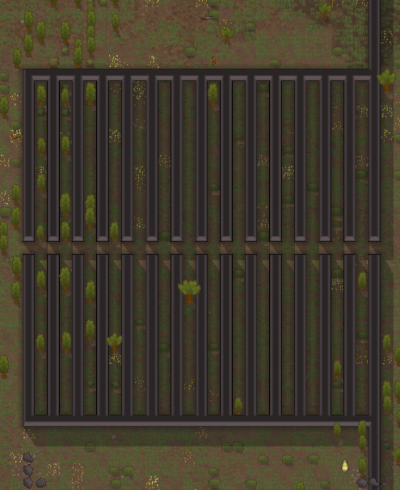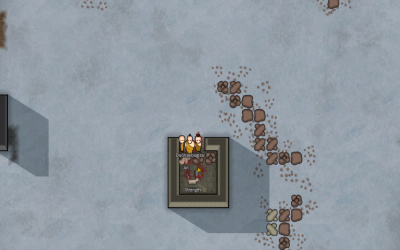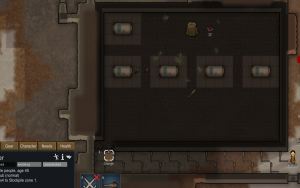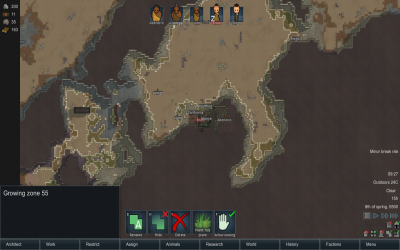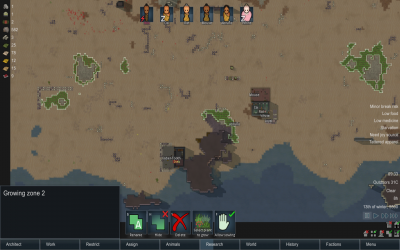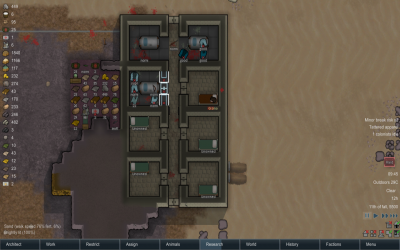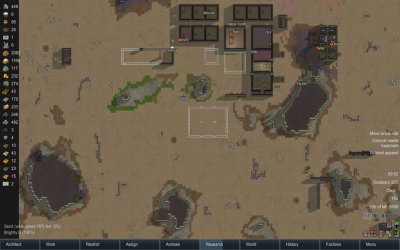User:PigeonGuru/Archive
Weapons (melee charge)
- High-DPS single-target weapons are optimal in this situation. Focus fire to break down shields and quickly down the exposed enemy.
- EMP weapons can be used to devastating effect by knocking out their shields with 1 hit. A lucky hit with an EMP shell can take out most of the shields in a melee raid.
- Explosive weapons may be used to break their shields, though they block the entire explosion so a single explosion won't hurt them much. They should be used in conjunction with EMP weapons if you're looking for #damage.
- Incendiary weapons penetrate the shield and set the raider on fire, distracting them. While their shields continue to block gunfire, the distraction makes it easier for them to be broken, as well as scatters enemies apart.
- Sniper rifles are capable of breaking a weaker shield with a single shot. Combined with their long range, this makes them a good supporting weapon to weaken an incoming charge.
- The Firefoam popper is a surprisingly effective option in this situation. In addition to spreading a wide field of foam over the ground that slows down anyone walking over it, the popper will deplete shields, stripping melee attackers of their crucial protection.
Weapons (manhunters)
High DPS weapons are good at taking down packs at close to medium range.
Long-ranged weapons work to provide long-distance firepower when paired with other high damage weapons, but are inadequate on their own.
The sniper rifle works well against larger animals, but is poor against hard-to-hit small animals, as a missed shot is punishing due to its long reload, and its high damage is grossly overkill.
Longswords, or any other high-damage melee weapon, are a must-have to fight off animals at melee range, which often happens with fast animals.
Crowd control
The Minigun is an excellent weapon against manhunter packs of any size. At a distance, it can destroy the tightly packed groups of incoming animals, while at point-blank, it can rip large animals to shreds, often with just a single barrage of bullets. Aim for an animal in the middle of the pack, and the bullets will hit others around it as well.
Chain shotguns are also a good choice at defeating manhunter packs at close to point-blank range, though its short range makes it risky to use against faster enemies.
Explosives are excellent at clearing out manhunter packs, when used carefully. They can hit a lot of animals at once, and don't miss easily, especially against small animals which can evade bullets.
- Rocket launchers are an effective yet easy-to-use one-use solution. Be careful when using them near your base or colonists though, and disengage if animals come dangerously close to allies.
- The Doomsday rocket launcher can obliterate a swarm of smaller animals using its giant incendiary blast.
- The Triple rocket launcher excels against larger animals with its high damage 3-round salvo.
- Mortars aren't very useful as animals generally run faster than the mortars can hit, but if you have a kiting colonist or trained animals distracting them and you aim ahead, you can still achieve great results.
- Grenades are good for groups, but are too short-ranged to be safe to use against raging animals.
Distraction structures
Once you have lots of bulk materials, but don't have enough industry to build proper defenses, you can build an distractions to temporarily delay raids.
Doing this can delay raids in early-mid game if you have the effort and materials, but as you enter mid-late game it's better that you replace the suppressor with something else, such as a killbox, which can actually bring the hurt.
Attention suppressor
Start like you're making a 29-wide room, but instead of doors, just leave one-tile openings at opposite ends. That way it doesn't get a roof. If needed, use a no roof area. Down the middle of the attention suppressor leave an open path, which will actually be traveled by your colonists. Pack the sides with alternating walls, leaving numerous blind alleys branching off the open path. The attention suppressor should look like two giant combs facing each other across the path.
A raider entering through an attention suppressor is presented with numerous blind alleys, each one of which could hold something important (in their perspective). Raiders will typically only resist the lure of a dozen or so blind alleys, before turning off into one to look for something to attack. In many cases they'll attack the walls, but the general effect is that a raiding force will spend a long time milling around in the attention suppressor, deeply distracted, and slowly trickle out of it toward your base alone, or (for a large raid) in twos and threes. This slow trickle of raiders is easily handled by a few colonists with basic weapons, or later a few turrets and a repairman.
Colonists and visitors with specific business on one side or the other of the attention suppressor will go quickly down the middle without being distracted. However, colonists pursuing joy activities like going for a walk will usually be diverted to do so in the blind alleys of the attention suppressor. As a result, it's not safe to fill with deathtraps.
Pros
- Effectively distracts and delays raiders
Cons
- Does not deal damage
- Takes up large amounts of space
- Expensive and time-consuming to build a lot of walls
- Makes it harder to eliminate all raiders at once
Dummy power grid
Place many wires randomly around the area. This causes enemies to stop and ignite or fight the wires, delaying them.
Note that they will charge immediately upon seeing colonists so this is a measure to buy time at best.
Ice sheet guide
|
 This guide was written on a timeline fashion so that your story can go parallel with the content of this page. This guide was written on a timeline fashion so that your story can go parallel with the content of this page. 
Ice sheet for Lost tribeIce sheet has no growing season, forget about plants. Livestock is limited, you will be hunting anything you can eat regardless of it's taste.
Start
SaunaAfter you are done enclosing your ancient ruin and had built both benches. Your next job is to use the steam geyser as main home due to it's heat source. Living on top of a geyser provides warmth enough to 10 degree Celsius, just to escape hypothermia. If your colonists complain about "sleeping in the cold", you tell them to man-up. The only two reasons to build a campfire are: to cook and an emergency extra source of heat when hard snow hits during Winter or a cold snap. Build a wall around (10x10 , the geothermal power plant is 6x6 so between the wall and the steam, the 8x8 line will become a one tile surrounding corridor just enough to place beds around), either by emulating a heater in the center of your room or by pulling a one tile corridor towards your home, even possibly digging a tunnel depending on the terrain altitude map of choice. Eventually, you should ideally repeat the same geyser-room procedure with other steams in proximity, this is because cold and starvation will not kill you, but mental breaks will. For example, having more than two characters on berserk. Sometimes, two geysers may be close to each other, allowing you to use them at both ends while you build everything else in between. This lucky situation can allow to start building individual rooms for your people and get rid of the barrack penalties.
Survival in cryptosleep like the spacersYou will survive in this biome, by sending all to cryptosleep except for the researchers. Be very careful here as occupants cannot eject by themselves and sending them all together won't let you continue playing unless a wanderer joins. You MUST keep an "active" hauler outside to open and free the others.
Before sending everybody to cryptosleep
Events that can help you survive
Caskets plus three formulaThere's really no need to murder your crew to reduce your roster numbers, instead, open the ancient structure. Let go of those who don't want to join if your original characters are too wounded by the time you are at this. Attempt capture if conditions are good. And also strip the downed as they may have pemmican, gold, components and/plasteel. How many characters you should have depends on many variants. A suggestion would be the total number of available cryptosleep caskets + 3. Between those three, two of them must be researchers and the other one extra a pawn that can serve the researchers by hunting, butchering and cooking for them. Then in any remaining time he/she would remain idle, join the researchers. Which means building additional two benches. Those that you choose to have them "awake" must have the capacity to HAUL. Or you won't ever be able to bring back those who you sent to cryptosleep. There will always be variables that won't let any player fix a number of "active" characters at a time. If food is low, you can continue with just both researchers. Less than two, you won't finish electricity research in time. You can also bring everybody else back to activity when circumstances require more people, such as raids. Because of emergencies, it's best if you can send them to cryptosleep with their bellies full and in good mood. You don't want to have them back active with hunger and metal breaks when you need them as back-ups. You can also store prisoners from pirate bands whose recruitment chance is over 95% as it may take too long and you don't want to waste food on them, and try to convince them only after you start to grow crops.
Pick your dream teamWanderers welcomed, escape pods welcomed and refugees welcomed. Immediately after opening all the cryptosleep caskets, pause the game and run a full check on each surviving occupants. This is particularly important for those who play with the first five random characters given, without randomizing to cheesy convenience. Check the spacers and see who could become a valuable member of your main team based on what you originally lack. The rest will become food, but don't forget to strip them first so that you can use their clothes too. Otherwise, the "used by corpse" penalty will punish the wearer.
CannibalismIt's inevitable. Just be very selective when butchering other humans as the character performing the action will receive mood penalties that can easily set it to mental breaks. It is okay if your characters complain of hunger. Again, keep your food supply on check and only feed your people when starvation kicks in, unless of course, their mental break is too dangerous to risk keeping them unhappy. When butchering human corpses it's best to set one same character to chomp many at once so that all the penalty goes to just that one rather everybody, and performing the action on same day will keep the penalty length shorter than extended after each consecutive day. Best the penalty wears off all together at once. Your best cannibal chef will be either of the two pair who just got married and is in honeymoon phase.
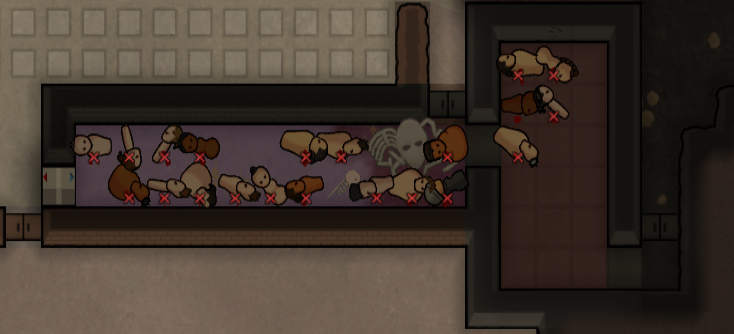
Technology sequenceAfter electricity, go for Batteries, Solar panels and then Stonecutting so that you can start building plantation-rooms. Sun lamps consume large amounts of electricity and you should by then have enough power and stored energy so that your crops grown steady. Solar generators will not perform to their maximum capacity due to the short solar cycles common in polar regions as oppose to equatorian regions.
Plantation roomAfter you have researched Electricity, Batteries, Solar Panels and Stonecutting AND crafted lots of stone blocks is when you can start building your first plantation room. Since the biome has scarce fertile tiles, you can easily select to mark a Grow zone and just drag your cursor on a 50x50 tiles area so that the game automatically marks where there is a "large" concentration of farmable area. Then just select the Sun lamp so that you can have the radius on your cursor ready to match such area. If you happen to lack said farmable tiles anywhere close to your base, you can fill in the blanks with hydroponic basins later on.
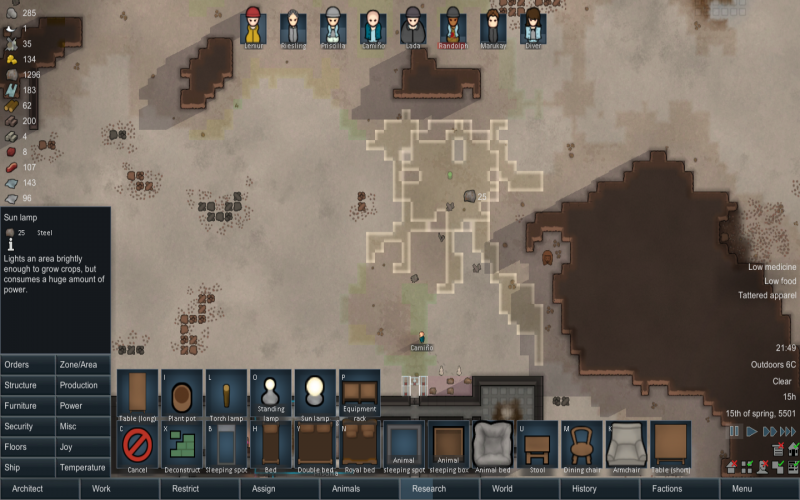
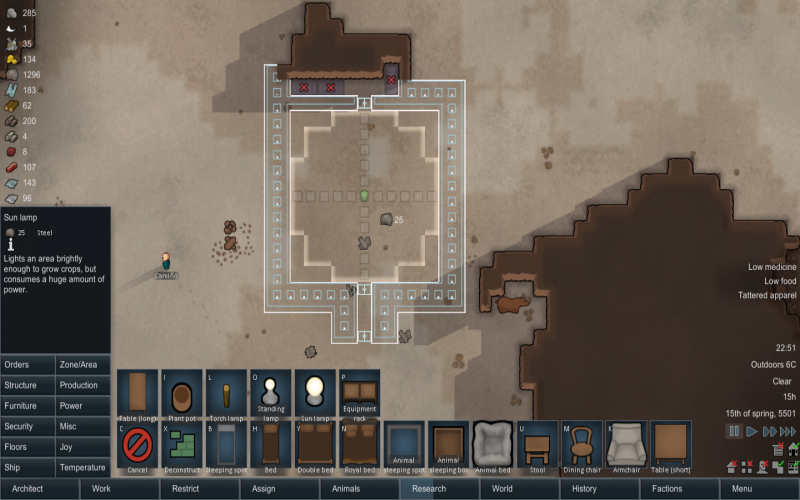
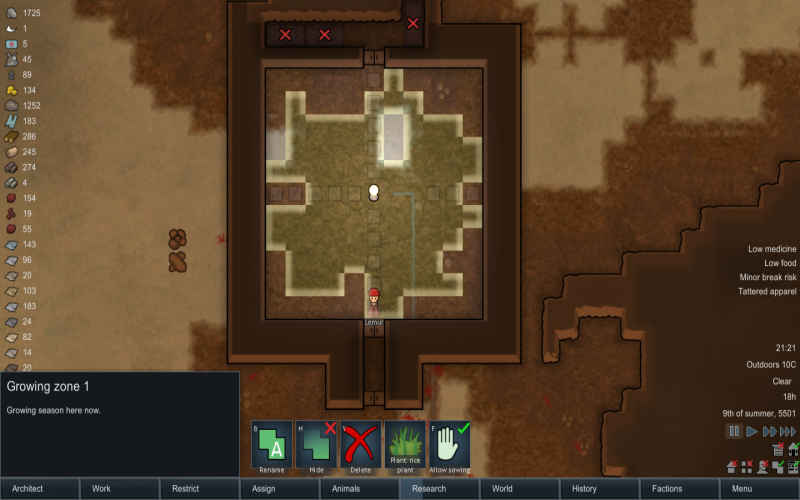
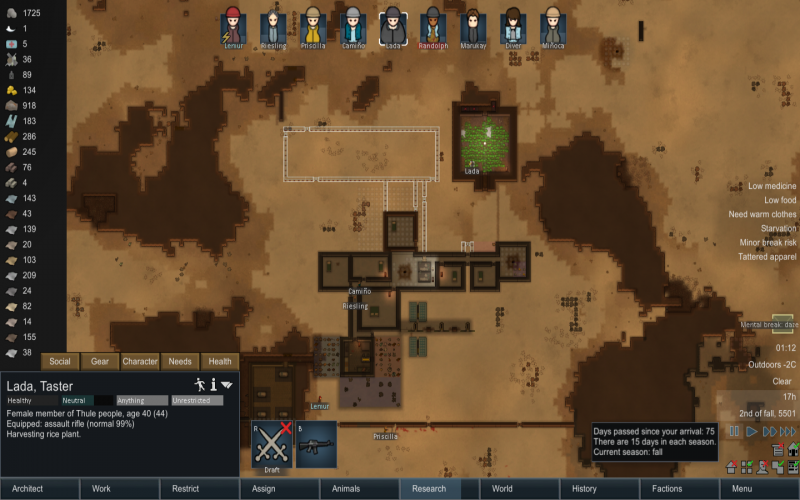
Extra contentThird yearMaximum capacity still restricted upon food limitations. Keeping some members on crypto sleep unless a party is announced, the mood bonus is cumulative. There has been no cannibalism since then but nonetheless keeping the extra meat. Solar flare can kill your crops so you still need to have wood stored to instantly build campfires to keep plantation rooms above -10 Celsius. Wild animal presence is rare compared to the beginning, even if leaving snow hares alive and feral, their predators hardly show up. Technological progress was crippled after losing a researcher, another one was recruited with 99% chance after a long convincing period. Wardrobe restriction of jackets, those who go hunting or mining will suffer hypothermia. Turtle march, slow but steady. While there is no need to build a large freezer, it is still necessary for summer and also because visitors with animals will eat your food (instead of theirs) if not stored in a closed area.
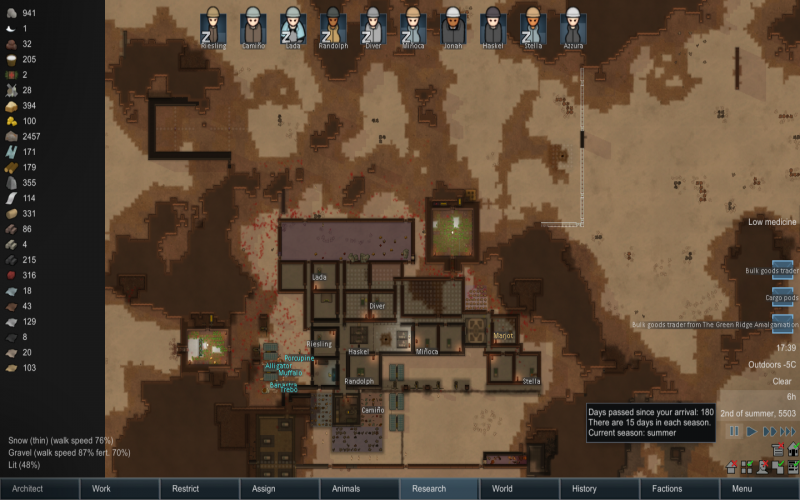
Fourth yearFood no longer an issue with cultivation switch from rice to potato. Loss of a cooker resolved by building a nutrient paste dispenser. By now, already extracting minerals for the spaceship with the ground-penetrating scanner. A 10 member ship will require:
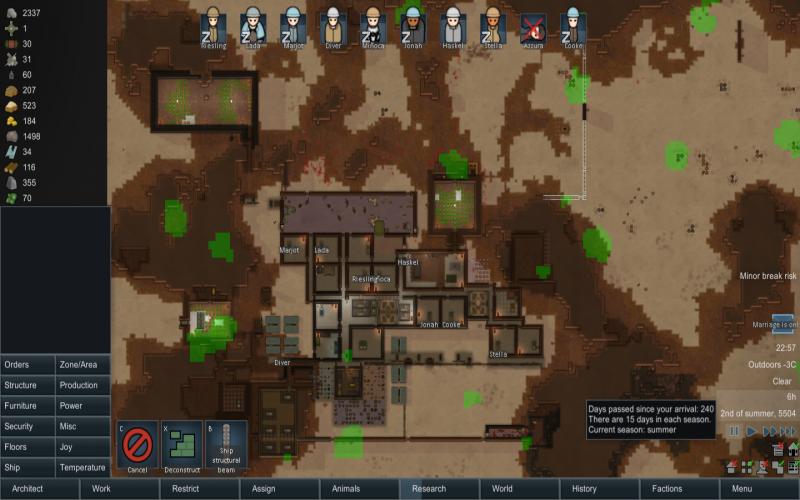
Fifth year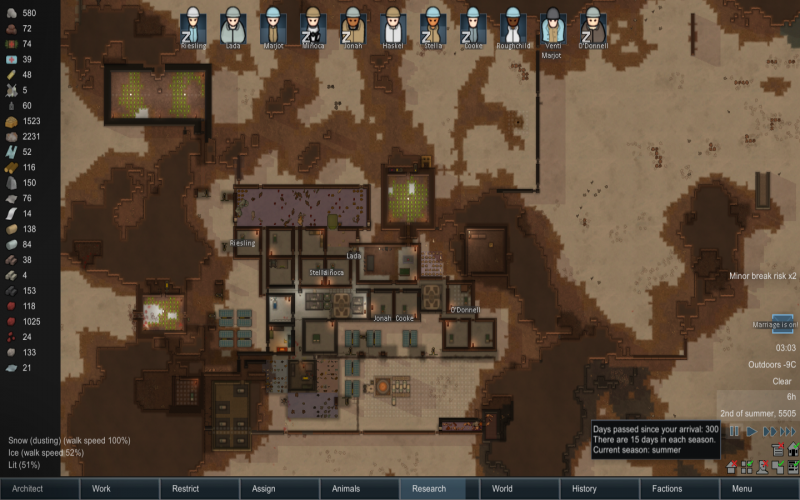
Attacking other FactionsViable only if within reasonable reach. Transport pods can make it possible but too much work for little benefit. If the desire is high, multiple settlements will be needed.
|
Extreme desert guide
This guide details how to survive in one of the most hostile environments in Rimworld - an extreme desert.
Brief
Extreme deserts are even hotter than a regular desert. Temperatures can be high enough to cause heatstroke for colonists that are not dressed for hot weather.
In an extreme desert plants are scarce and there is a lack of fertile soil to grow plants in. Although in normal deserts there are still small parches of arable land, in an extreme desert there are only gravel patches available to farm on.
Starting area
It is important to consider the terrain of your extreme desert. The main two options are flat maps and hilly/mountainous maps.
- Flat maps will have growing zones scattered on the map randomly while high altitude maps will mostly have growing areas at the foot of the mountains. This means it is possible to centralize your colony on a flat map while on a high altitude map your growers will have to travel further.
- Flat maps will have more animals like Dromedaries, Fennel foxes and Iguanas. Foxes are the only threat present when hunting. There may also be some Megascarab on the map which while slow, can cause a lot of damage to your colonists so it is important to take care of them early on.
It is not recommended to pick flat maps near the sea since they have less area available for building and the water cannot be used for fishing.
Lost Tribe
- Main Article: Scenario system - Lost tribe
- Find and claim an intact structure that can fit five characters. The starting wood should be reserved for doors and coolers only.
- Prioritize mining and crafting. It is important to conserve materials therefore place all production benches inside one large room.
- Hunting will be one of the main food sources at the beginning since the starter pemmican will run out quickly. Hunt everything on the map and build a butchers table. Harvest any agave and other resources on the map. Starter animals can also be a source of food.
- Immediately start growing rice at the beginning.
- Only build essential production benches such as a stonecutting bench and a butchering bench. Try to use steel that can be found on the map instead of the starter wood.
- At the beginning feed your colonists raw food until you research electricity.
- If there is a heatwave build passive coolers. This is the reason wood needs to conserved since a heatwave can easily wipe out your entire colony.
- Using a tailor bench, craft cowboy hats and dusters as soon as you can from leather, and later on once you have a good supply of food, from cotton you have planted.
- Research: If playing on a flat map, stonecutting will be important to allow you to build more walls. If playing on a mountainous maps, it is possible to build a colony inside the mountain and start researching electricity first.
- The very first visitor will be your savior as will be bringing some pemmican, but with just 200 starter silver, you can only buy like 55 units which isn't much or 60 if selling the spare weapon.
Food
Immediately start growing rice or you won't make it past a week. Rice is not a good choice of crop in poor soil, but they grow fast. Once you have decent food stocks, replace this with potatoes as they perform better in poor soil.
Somewhere around your fifth day, your colony will have no food available at all and your only chances for survival will be opening an ancient shrine and hope there is at least one hive that has a spelopede or megaspider to hunt. These creatures will chase any intruder up to some 30 tiles away from their hive so they won't chase you forever, but they are very fast. Since you only start with two short bows and a bundle of pila, it is still possible to hunt without harm but will require good concentration and familiar tactic knowledge of kitting. To kite, means having a fast bait run towards a direction where nobody else is, while at the same time, the others shoot at the chasing creature. Use the Plan grid to draw their attack range.
If you are lucky, the same moment you need to open the ancient shrine will coincide with the timing of your first newcomer who might be better equipped to hunt, most likely a pistol. Which means you can go to up a max of four hunters. One more mouth to feed but safer hunting. The newcomer may likely as well arrive with some packaged survival meal, but it won't be enough for more than a day.
Insect jelly will start spawning, which will become another nutritional source, and this one never rots. But, hives will live so long as there is a guardian keeping maintenance, and if you kill them all, they will stop producing jelly. Soon after, by the time you might be picking them up. Glow pods will appear too, replacing torch lamps.
Animal herds may also help you survive from starvation.
Check your rice plantation periodically, as the plant can be harvested as early as 66% growth. While it may not yield much food, it's still better than nothing.
Check on the few agaves, they may be ready for harvest by now.
Check if any other life form has ventured to your territory.
Reached your first 100% ready harvest? Congratulations, you made it!
Gathering materials
Due to the lack of trees, instead of using wood (Saguaro cactus provide merely 13 wood), it is best to build with steel as there's abundance in comparison, so it is wise to start mining this resource before you need them. Later on after researching stonecutting, you can upgrade to stone.
Those in high elevation areas should start caving in. During this process you may likely strike other minerals, which are slower to mine. But their empty space will do better for laying out a proper cave system, otherwise you will find yourself mining too much when going after said minerals gaining more work afterwards with the increasing need to build walls where those minerals were located to avoid mountain roof collapse.
Remember that ancient shrine? That room can also be used to build more facilities.
Continuing research
Did you notice winter temperature is around 30 Celsius? Imagine peak summer time. Double time on research to get electricity. Lucky if you have a night owl in the team.
Summer
Summer is going to start soon, and while the season itself is not a threat, heat wave is as it rises temperature up to 60 degrees Celsius. You will need to build passive coolers which require 50 wood each so that your colony doesn't die of heatstroke. Any temperature below 30 degrees Celsius will allow your people to recover at night.
Base relocation or upgrade
After you have gone past your first heatwave, it's time to make life more comfortable so that none of your people are psychologically nor emotionally disturbed. Try to make the most of the whole map with as less effort as possible. And the rest it's up to you. Good luck!
